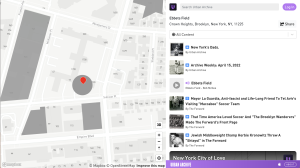I enjoyed the opportunity in this course to learn about participatory libraries and service, both in theory and action! Matthews, Metko, and Tomlin’s article, “Empowerment, Experimentation, Engagement: Embracing Partnership Models in Libraries,” brought to light a point about participatory relationships that is key to my interest in public librarianship. They asked, “What relationship do we want learners to have with their library? One that is grounded in dynamic, interdependent partnerships” (Matthews, etal., 2018). The term interdependence resonates with the goal of hyperlinked libraries and the framework that librarians should approach change and participation in a Library 2.0 model that pushes beyond a checkbox for public comments (Casey, 2011). We depend on one another to learn, grow, and connect, and we are all better for building an interconnected community of information seekers, digitally and in-person. In a hyperlinked library model, I see librarians as part of this interdependence; we have as much to learn from our customers as they do from us – there is no hierarchy of expertise! Michael Stephens speaks to this theme powerfully in The Heart of Librarianship in his insistence that true participation of customers “requires engaged participants who feel welcome, comfortable, and valued,” or, as Serhan Ada states, a guest becomes a host (Stephens, 2016, p.81). I am very pulled to this question of how library customers can become library experts, library hosts, or library leaders. How can participatory libraries and services ignite ownership and curiosity among all library users?
I investigated this concept further, guided by the themes of interdependence and library users as hosts, and delved into readings about popular education and critical information services.
Popular education is commonly implemented in South American movements led by marginalized peoples, Paulo Freire being the most well known scholar (What is popular education?). I also found that the method is commonly implemented in Scandinavia. These approaches politicize learning and teaching by acknowledging that they are always mediated by power dynamics between class, race, and other identities (Tewell, 2016). Popular education as a method breaks down the distinction or hierarchy between learner and teacher so that all participants hold equal expertise based on their situated knowledge of a given topic, which rings similar to Matthew, etal’s statement of interdependence and Ada’s statement to transform customers to hosts (What is popular education?). However, popular education tends to be implemented outside of educational institutions, commonly utilized by community organizers, social justice groups or self-organized study groups/DIY spaces.
From Barbara Fister, “critical information literacy asks librarians to work with their patrons and communities to co-investigate the political, social, and economic dimensions of information, including its creation, access, and use. This approach to information literacy seeks to involve learners in better understanding systems of oppression while also identifying opportunities to take action upon them” (Tewell, 2016).
This approach to librarianship recognizes and interrogates the power structures underpinning information services and literacy practices to work towards a more just system that serves all people (Tewell, 2016). Libraries are not neutral institutions that deposit information into users. Patrons are producing knowledge themselves and “co-investigating” with librarians.
Can popular education and critical information literacy be implemented in public libraries? Researcher Lisa Dahlquist is a proponent of popular education in Swedish libraries and discusses how it promotes a library’s role to support a democratic society that invites universal participation, reflection, and dialogue (p.10). She argues that popular education approaches will only support the complex identities and diversity of needs that libraries must hold and adapt to in a changing, increasingly digital world. Dahlquist shares the example of Agora, a “creative meeting place,” which includes a library, cafe, stage, media center, and more. Visitors may organize their own public classes or study groups to share in community with others; in short, the programming and educational approach invites patrons to produce knowledge together, which holds potential for popular education (About Agora). This creativity center is similar to The Mix teen space in San Francisco Public Library (O’Brien, 2019).
Rachel Hall emphasizes the need for critical information literacy in public libraries. Though letting go of the idea that libraries are politically neutral may be difficult for some, there are many benefits to shaping library programming and services based on the pressing, even controversial issues a community faces and actively recruiting the public in conversations about how to make meaningful change (Hall, 2010, p.168).
These approaches politicize participatory librarianship and strive to ignite library programs and services towards social justice in and out of the institution. I have just brushed the surface (and run up to the word count) on these topics, and I really look forward to learning and hearing from others!
BIBLIOGRAPHY
About Agora. Agora. Retrieved 17 February 2024. https://www.linkoping.se/agora/om-agora/
Avery, H. (2017). Teacher and librarian partnerships in literacy education in the 21st century. BRILL. ch. 4, 45 -61. https://ebookcentral.proquest.com/lib/sjsu/reader.action?docID=4822881&ppg=53
Casey, M. (2011). Revisiting Participatory Service in Trying Times – a TTW Guest Post by Michael Casey. Tame The Web. https://tametheweb.com/2011/10/20/revisiting-participatory-service-in-trying-times-a-ttw-guest-post-by-michael-casey/
Fister, Barbara. “Practicing freedom in the digital library.” Library Journal, 26 August 2013. Available at: http://lj.libraryjournal.com/2013/08/future-of-libraries/practicing-freedom-in-the-digital-library-reinventing-libraries/ (retrieved 12 February 2024).
Hall, R. (2010). Public Praxis: A Vision for Critical Information Literacy in Public Libraries. Public Library Quarterly (New York, N.Y.), 29(2), 162–175. https://doi.org/10.1080/01616841003776383
Matthews, B., Metko, S., & Tomlin, P. (2018). Empowerment, Experimentation, Engagement: Embracing Partnership Models in Libraries. EduCause Review. https://er.educause.edu/articles/2018/5/empowerment-experimentation-engagement-embracing-partnership-models-in-libraries
O’Brien, C. (2019). How San Francisco’s public libraries are embracing their changing role. Shareable. https://www.shareable.net/how-san-francisco-public-libraries-are-embracing-their-changing-role/
Pihl, J., van der Kooij, K. S., & Carlsten, T. C. (Eds.). (2017). Teacher and librarian partnerships in literacy education in the 21st century (1st ed. 2017.). Sense Publishers. https://doi.org/10.1007/978-94-6300-899-0
Stephens, M. T. (2016). The heart of librarianship : attentive, positive, and purposeful change. ALA Editions, an imprint of the American Library Association.
Tewell, E. (2015). A Decade of Critical Information Literacy: A Review of the Literature. Communications in Information Literacy, 9 (1), 24-43. https://doi.org/10.15760/comminfolit.2015.9.1.174
Freire Institute. Retrieved 17 February 2024. https://freire.org/home
What is popular education? Teaching Democracy. Retrieved 16 February 2024. https://teachingdemocracyblog.wordpress.com/aboutwhat-is-popular-education/


